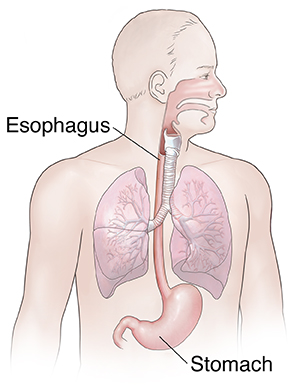The esophagus is a muscular tube that joins your mouth to your stomach. Coordinated contractions (peristalsis) in the muscles in the esophagus help food move down to the stomach. When these muscles tighten or contract abnormally, it's known as spasm.
Esophageal spasms may feel like food is stuck and won’t go down. It may cause a feeling of heartburn or a squeezing type of chest pain. The pain may spread to the neck, arm, or back. This pattern of pain may mimic heart pain or angina. If you try to swallow more food or liquid during a spasm, it may come back up within seconds (regurgitation). Symptoms may last for a few minutes to an hour. They may occur from time to time, or they may be persistent in some cases. Certain foods or fluids may trigger symptoms, such as very hot or cold liquids or foods not chewed well.
The exact cause of esophageal spasms is not known. But they often occur with acid reflux and GERD (gastroesophageal reflux disease). Long-term acid reflux may increase the acid content in the esophagus, causing spasms. Problems with nerves supplying the esophageal muscles may also play a role.
Your healthcare provider will diagnose esophageal spasm based on your medical history, a physical exam, and certain tests. These may include barium swallow, endoscopy, and esophageal manometry.
Home care
Medicines
Your healthcare provider may prescribe medicines to help reduce your symptoms. If you have an underlying condition such as GERD, your healthcare provider may prescribe medicines to help manage it.
Take all medicines as prescribed. Don't take any medicines without talking to your healthcare provider first. If medicines don't work, your provider may advise botox injections or surgery.
Diet
-
Limit any foods that seem to cause spasm. This may include very hot or very cold foods.
-
Eat slowly and chew food well before swallowing.
-
Don't drink alcohol or caffeine. Don't use tobacco. These can delay healing and make the problem worse.
-
Try peppermint lozenges or a few drops of peppermint oil in foods or drinks. They may help ease symptoms.
-
Try eating smaller meals. Have small snacks in between.
-
Don't eat a large meal just before you go to bed.
Follow-up care
Follow up with your healthcare provider, or as advised.
When to seek medical advice
Call your healthcare provider if any of the following occur:
-
Food that feels stuck in the esophagus for more than 30 minutes
-
Inability to swallow solids or liquids for more than 30 minutes
-
Symptoms that feel like esophageal spasm but occur with heavy sweating, dizziness, or shortness of breath
-
Change in the usual patterns of your symptoms of esophageal spasm. This might be a new pattern of spreading to the neck, back, shoulder, or arm, or pain that is worse than usual.
-
Unintended weight loss
-
Lifestyle changes don't provide relief
-
Symptoms get worse or you have new symptoms


